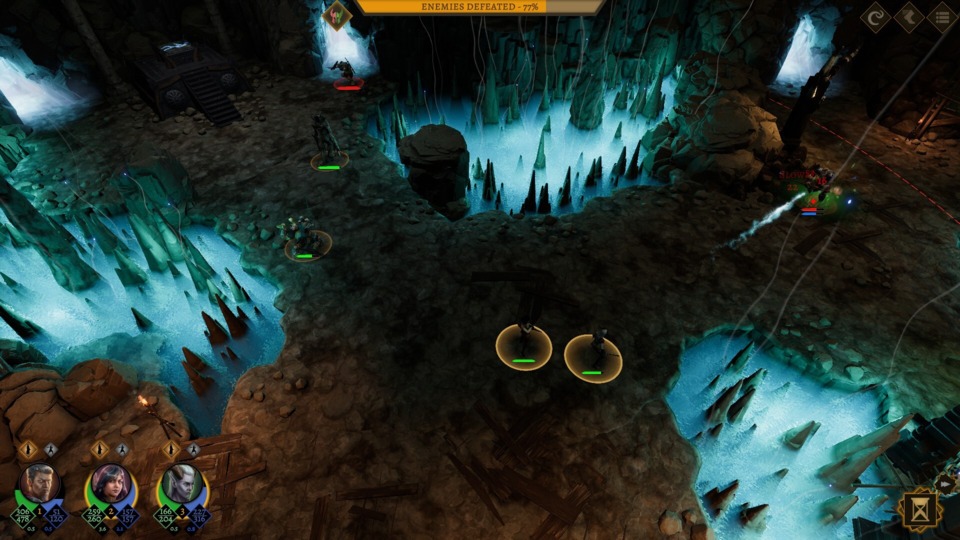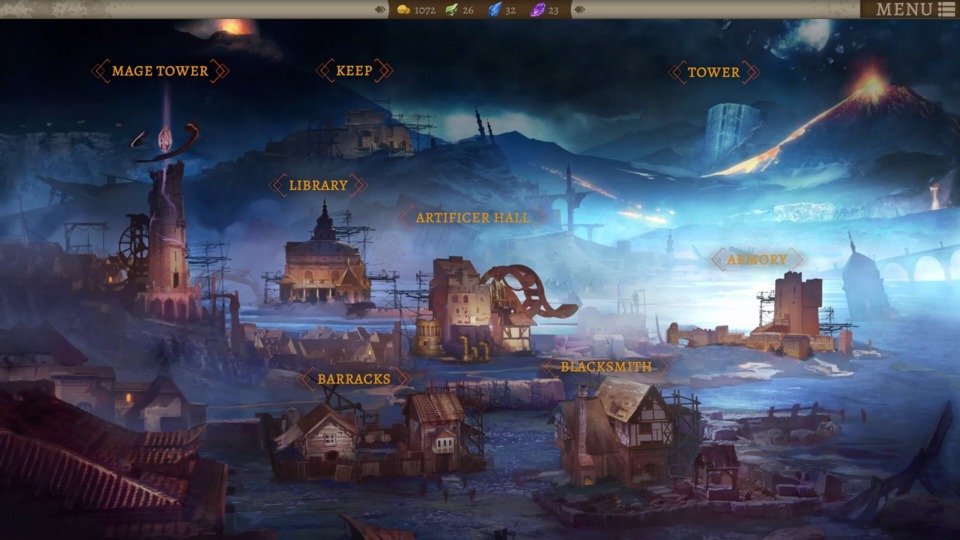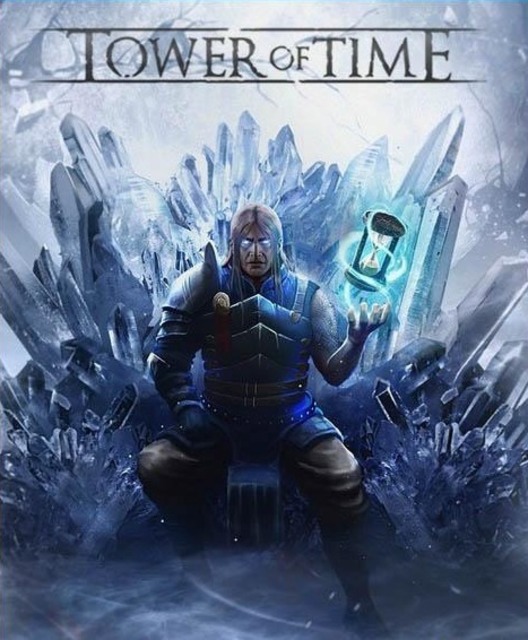
One week into January is a good time for contrition I've found, since most of us have already broken any and all New Year's Resolutions we'd optimistically set ourselves. In my case, having long since abandoned any pretensions towards self-improvement, this sheepishness is instead aimed squarely at a fellow Bomblogger: one Mr. @arbitrarywater. See, the stand-up duder in question gifted me this entry's Indie Game of the Week as a fellow CRPG nut curious to read my reactions; however, I've actually forgotten how long ago it was since this game showed up in my Steam library on that generously fateful (fatefully generous?) day. In my defense, it wasn't until I bought a stronger PC that I could finally run it without issues. That is, the PC I bought last December. Uhhhhh well, I'm playing it now, and as we say here in the titular chronological fortress "better late than never", a statement heard only slightly less frequently than "stop sitting on your ass and protect my mages already, you stupid tank".
Tower of Time is a tactical real-time RPG with... well, not so much turn-based but "slowed down enough to let you collect your thoughts"-based (though fully halting the action is available as an alternative). You control a party of four champions loyal to you, the big important unnamed protagonist who ominously introduces himself as "The Destroyer" during the in media res introduction, as you send them down through an inverted tower reaching deep into the earth to their probable grisly deaths. Due to some poorly-maintained arcane energies and a whole lot of incidental bad shit going down besides, the tower is full of monsters and traps but also purports to hold the salvation for the surface world through ancient technology and thinking lost to the current surface world, presently undergoing a very slow apocalypse for reasons lost to history. Point being, this tower seems pretty important and everyone's pushing past its many obstacles to find a path to a brighter future at its base (or its top, depending on your perspective).
Units in battle automatically attack anything in range, with an optional toggle to have them march towards the nearest enemy to fight or stand their ground (the latter preferable for squishy ranged types) but the player is in charge of everything else, including skill usage and positioning. Enemies spawn in from multiple directions, requiring your best crowd control and situational awareness as you chip away at the encroaching hordes while keeping your team alive and (ideally) buffed to the nines. Roles naturally fall under the usual archetypes—tanks at the front line to soak up damage, support for heals and buffs, DPS to take down foes tout de suite before they overwhelm you—and the game provides a set of pre-determined characters (with newcomers doled out at about a rate of one per floor) with similarly pre-determined skillsets that you have some minor customization over, in particular regards to the skills you choose to upgrade and the alternative upgrade paths you might follow. An example might be an AoE attack where you can either upgrade its splash range or its damage, your preference being contingent on how you're using it (either demolishing larger groups of weaker mobs or taking down bosses/spawners and their adds quickly, respectively).

The situational awareness factor takes a much more critical role in this game than other RPGs of its type, as you're frequently required to move units out of the way of incoming enemy AoEs or having to quickly account for a bunch of mooks that spawned in behind your archer and mage while your tanks were out in front. Hitting the space bar to slow down the action gives you time to react to these new developments, as well as toss off multiple skills on the trot. These skills are limited by both cooldowns and a finite mana gauge, though the regeneration for the latter can be improved with the right enhancements on your gear (and probably should for mages). You're also only able to equip four skills per character, out of the eight they eventually acquire through levelling up, further adding to the player-directed specialization aspect. To account for the somewhat small number of character customization options, the game has multiple battle scenario "types" that it'll throw at you including demolishing monster spawners, either destroying or avoiding enemy orb turrets, protecting your own orbs (something I already do habitually thanks to some painful lessons learned during dodgeball in gym class), or rescue a fellow comrade from a sturdy cage before the enemies arrive to ensure I have my full fighting force ready to go. Many battles will also add bonus conditions, making things easier or harder for you or the enemies by way of slowdown, lower elemental resistances, or extra health regen. Where it might falter in giving you a wide spread of tactical options (there's little reason to change things up unless you recently acquired new skills or an enemy proves highly resistant to your favorite element) it makes up for it with these varied battle scenarios.
Notably, the game eschews an XP system: your characters are already as skilled as the world's strongest according to the in-game explanation, so the only way to improve is to study whatever ancient fighting techniques and magicks you can gather from this tower and pay for training. This means that both equipment and money are tantamount to succeeding in battle, at least in preparatory terms. As such, I've been exploring floors until I see a battle on the horizon—no battles are random, and enemies will simply stand in the road until you're ready to face them with the exception of a few sudden ambushes—and then walk the opposite direction for a while. After all available looting opportunities are exhausted, I can peruse my inventory to make sure I have the best gear equipped and maybe hit the trainers back in town to be fully primed for whatever the next fracas has waiting for me. Best of all, the game is very forthcoming with information about the current floor: the number of battles, treasure chests, secret areas, side-quests, and other notables are all made apparent to you as soon as you enter, ensuring that you don't miss anything before you find the exit and are prepared to move on. There's also intra-dungeon fast travel for quickly getting back to splits in the path you left behind, and moving back and forth from the hub town is mostly instantaneous: the game has been very accommodating so far, saving all its challenging moments for the battles themselves.

There's plenty I really like about this game, and only a mild layer of jank that's worthy of kvetching about. The combat recalls a little game from Cyanide I played a while back called Aarklash: Legacy (hard to miss it, since it always sits at the top of my alphabetical Steam library) that had a similar "what if Infinity Engine games did way more with the repositioning aspect of its real-time combat?" epiphany, and none of the battles so far have been either too difficult or too easy (that's on Normal difficulty, mind). The dungeon exploration half hasn't been slept on due to the combat focus either: each floor has its own distinct personality, its own role back when the tower was newly built that in some way has influenced the state it's in now (very Ultima Underworld), and its own bonus areas and unique challenges to find and overcome. There's a ton of flavor text—and some inescapable typos, given this is an ESL game—so it regularly feels like a tabletop RPG experience, even without the guy spilling soda on my character sheets ("Hey, you said you liked 'flavor text'!" Yeah, thanks Gerry). It even does the Divinity: Original Sin thing of having your teammates bicker over certain dilemmas until you step in with some problematic mind manipulation to settle their disputes (you can leave it to chance too, if tinkering with your friends' brains is somehow not to your liking). I keep entering each new floor excited to discover what's next, and how my battle strategy might change with each new level up or character introduced to the mix. If you're a fan of color-coded loot (and by golly I am) this game has a bunch of it, even if you run into the usual procgen issues of, for example, finding way too much mage equipment that boosts your melee strength—thankfully, you have the means to make your own gear if the stuff you find isn't to your liking. Not for the first time, I find myself thanking ArbitraryWater for his recommendations and contributions to a backlog that's proving to be every bit as bottomless as this tower. Still, I have a whole new year to spend delving ever deeper into it so I can't say I'm not content right now.
Rating: 4 out of 5.
Post-playthrough update: The rest of the game was more or less the same, though it did feel like it was running out of steam towards the end (or maybe that was just me). After undead, orcs, and elemental constructs it kinda got stuck on golems for a while. There was an interesting twist (and one germane to the name) where you met the extradimensional orcs again near the end but they were way more advanced; turns out their world portal was several hundred years ahead of the previous, and they'd been chased through on this occasion by a bunch of genocidal human purists (who, charmingly, had leaders named for American colonists like Hernan Cortes). The ending was... well, it was something. What's odd is just prior they set up a sequel hook involving a minor antagonist, but I'm not sure how they're going to resolve it given everyone in your party died. Definitely a memorable game with more than a little bit of jank, but some novel ideas and an appealing enough tactical real-time combat system. (Once I discovered the auto-cast function and given everyone mana-regen-boosting gear, the battles got considerably easier.)
| < Back to 350: The Forgotten City | 001-100 | 101-200 | 201-300 | > Forward to 352: Itorah |

Log in to comment